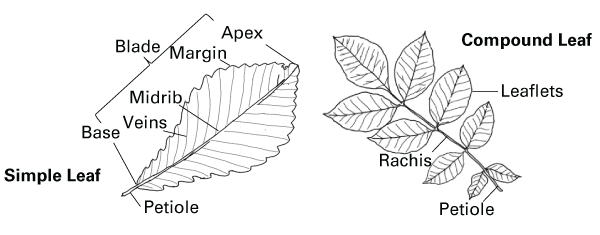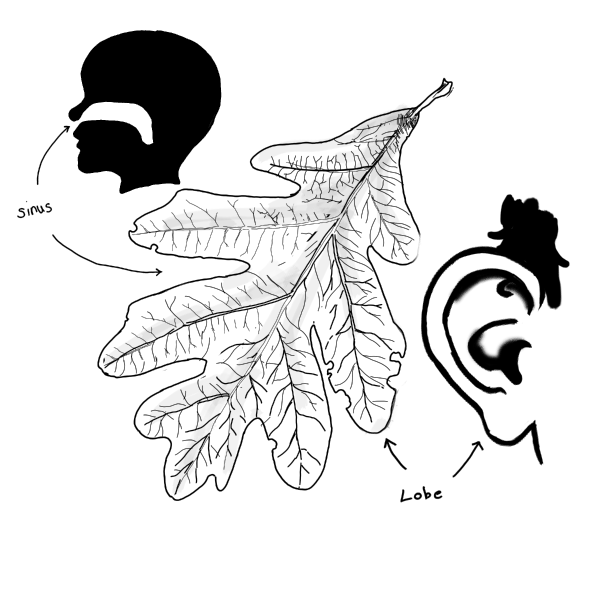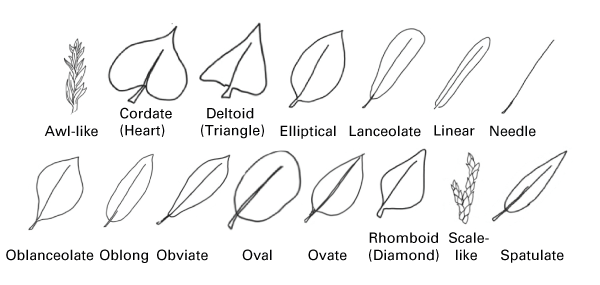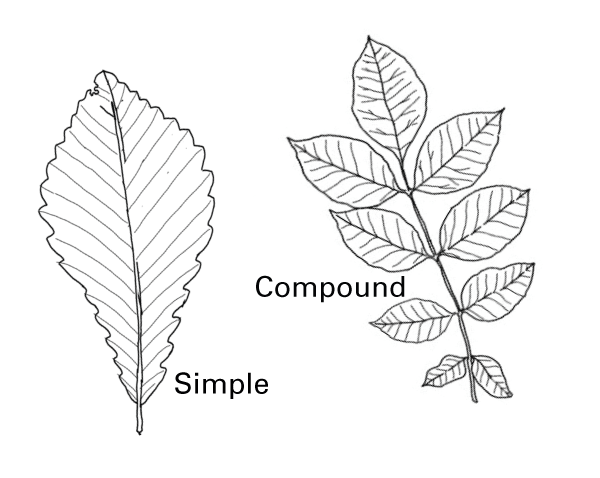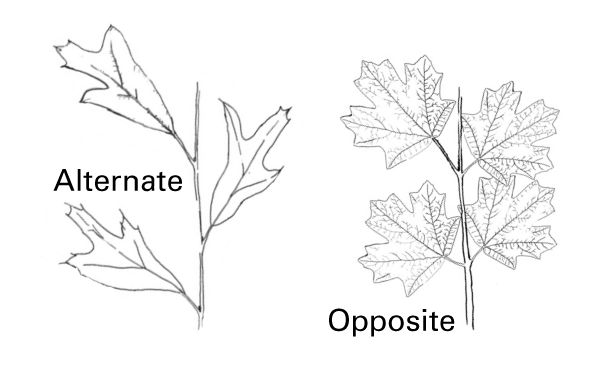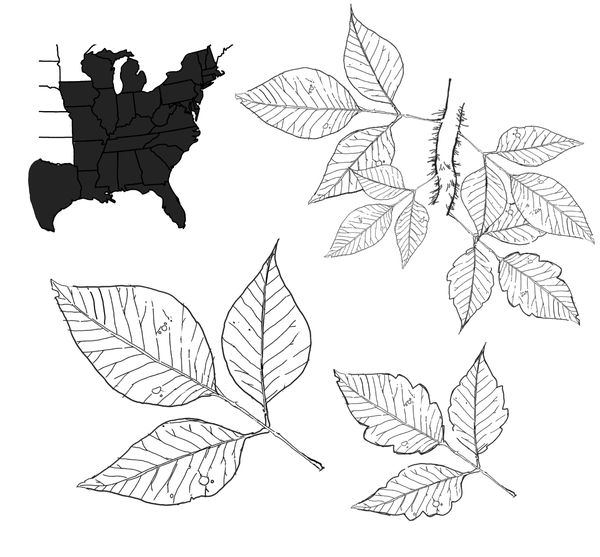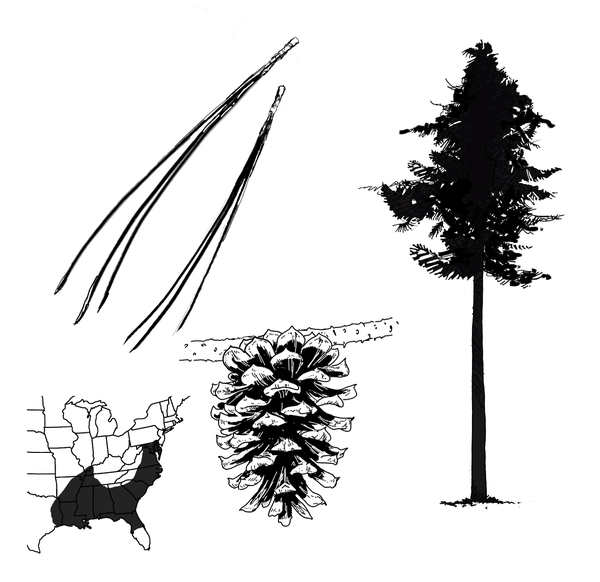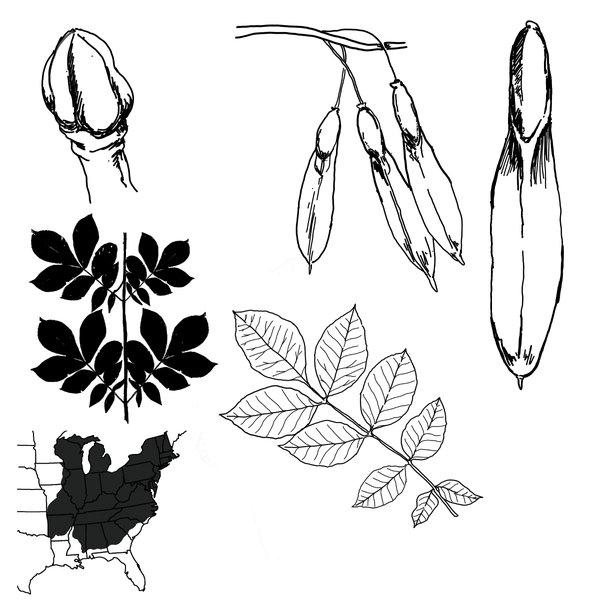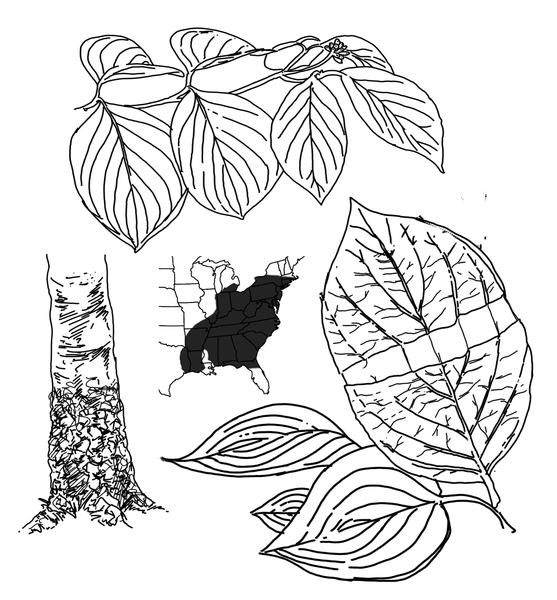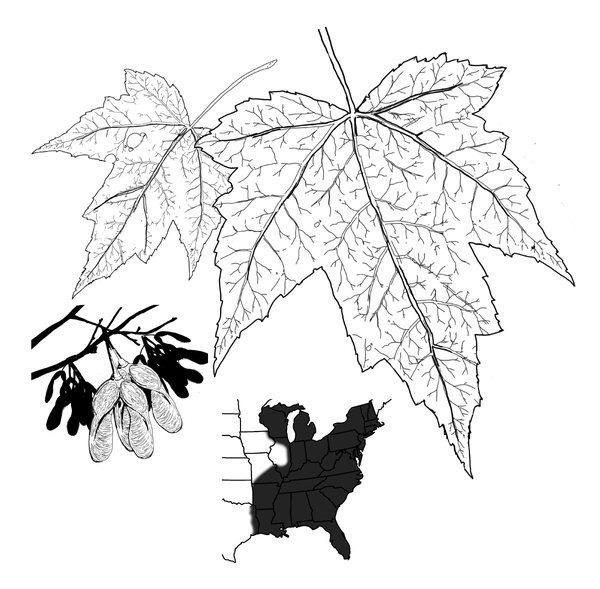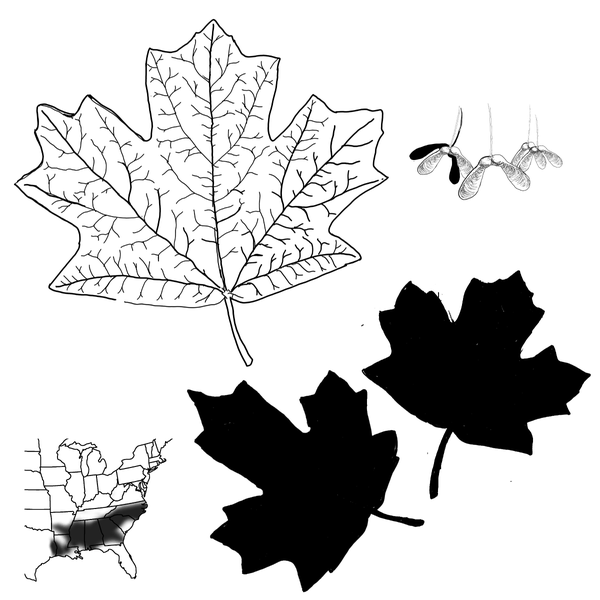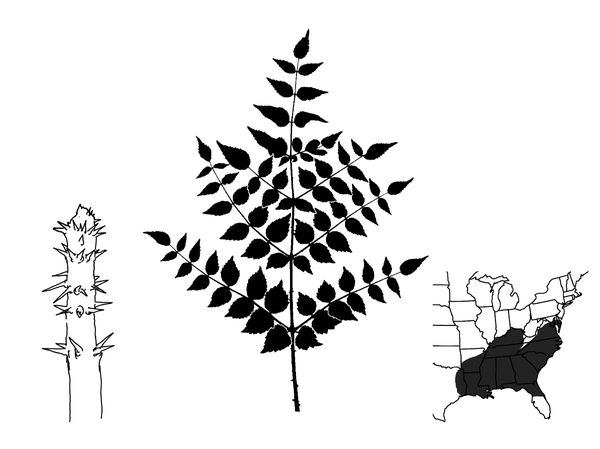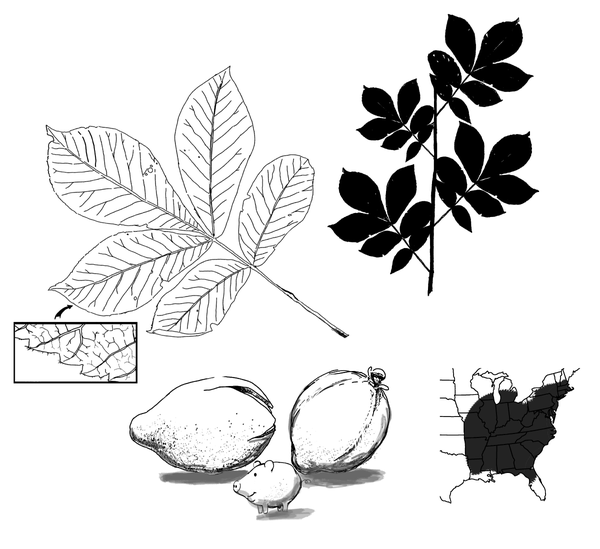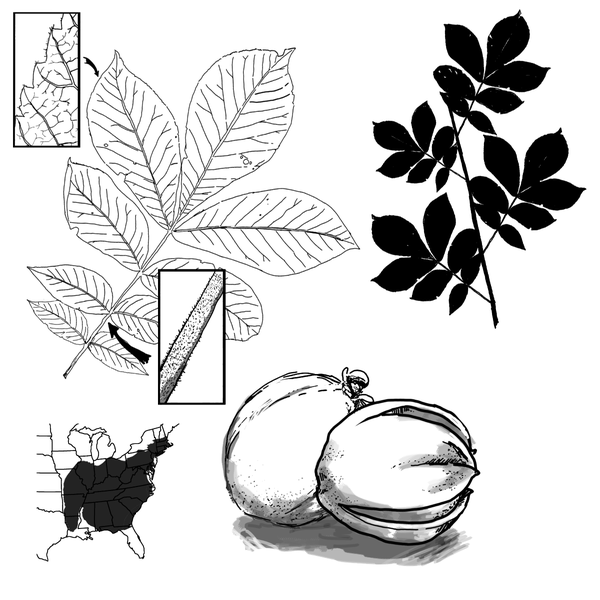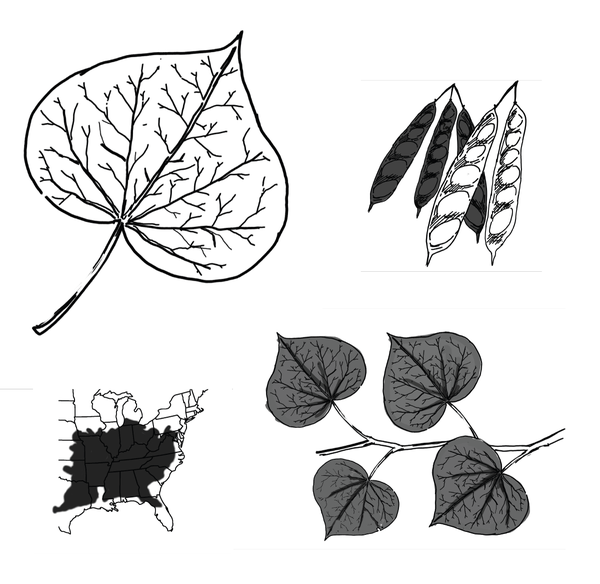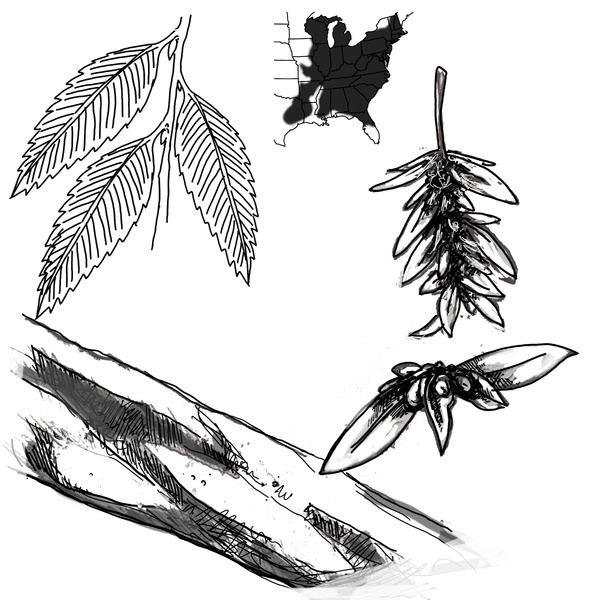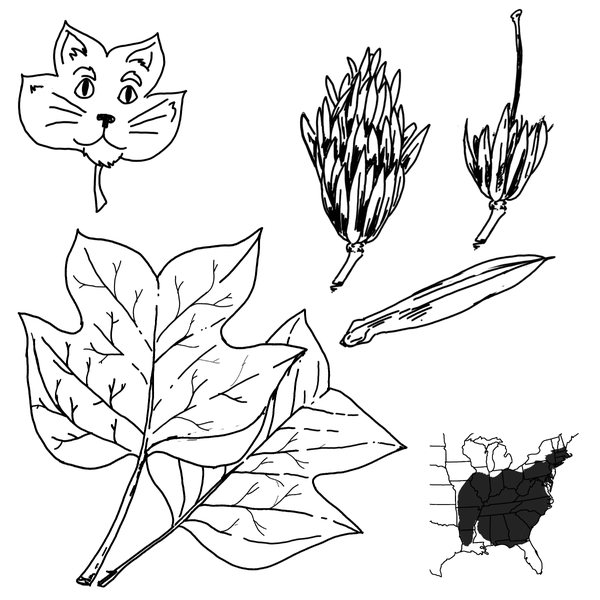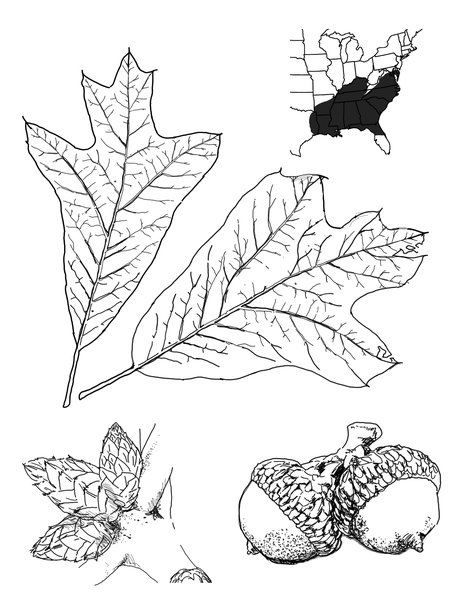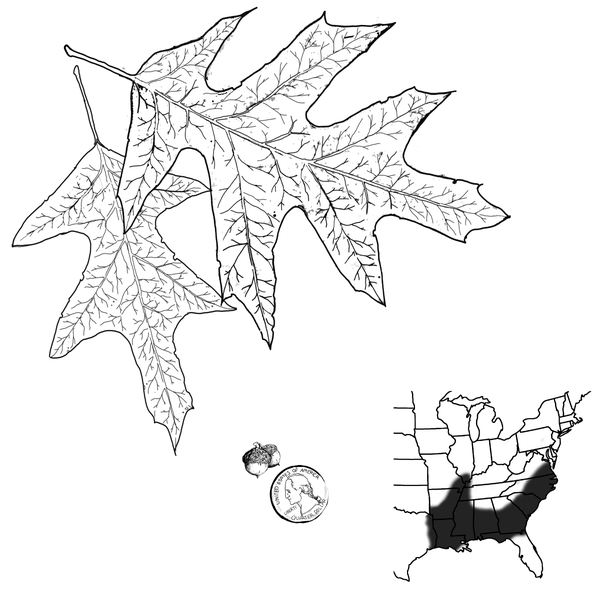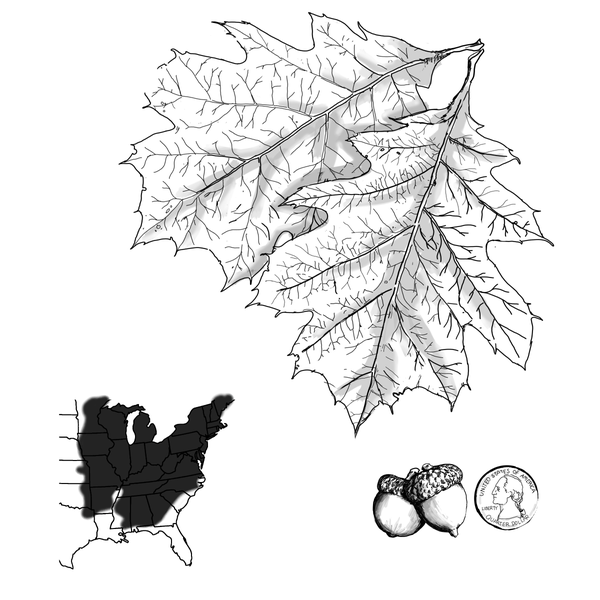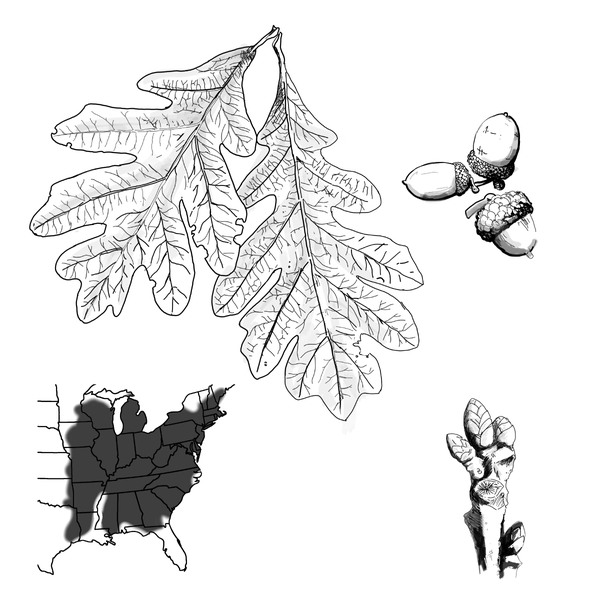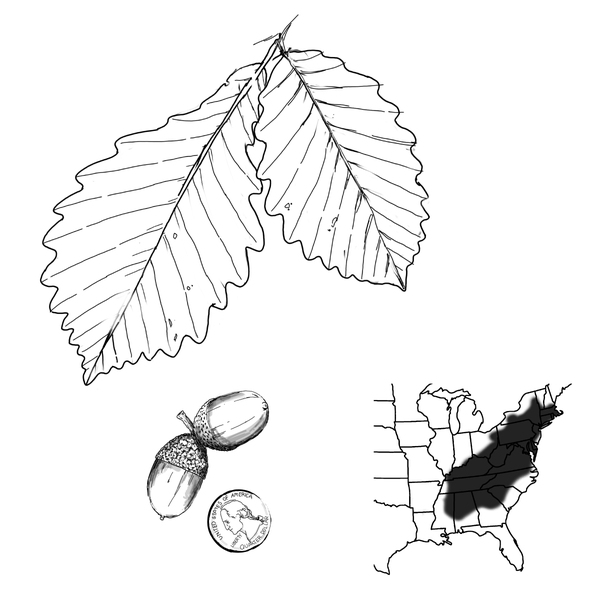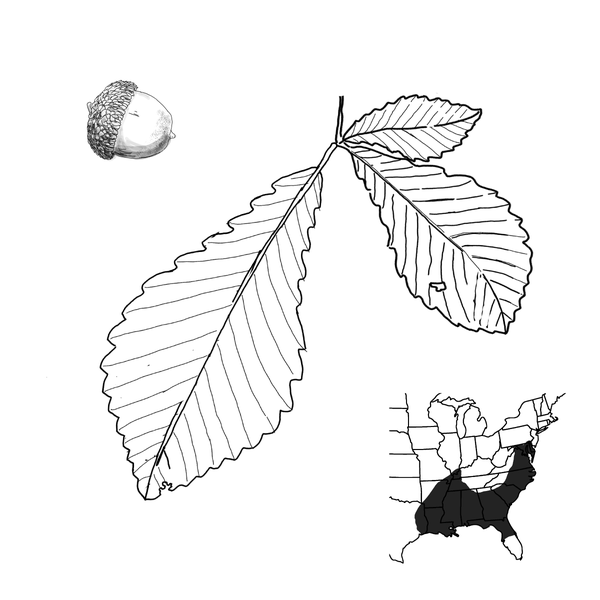Introduction
As you explore the trees around you, have you ever wondered what type of trees they are? It may be easier to answer that question than you think. Identifying trees requires some careful detective work on your part, but it can be fun and easy. By examining different tree parts and using a simple process of elimination, you will be able to identify trees with confidence. This publication is designed to teach the basics of tree identification by using your observation skills and a dichotomous key based on leaf characteristics. This publication will help you identify 21 common tree species of the hundreds of tree species found throughout North Carolina.
Leaves
The most common characteristics used to identify trees are the leaves because trees produce leaves that have the same physical characteristics. An example would be pine trees that produce leaves shaped as needles. To use the physical characteristics of leaves to identify trees, it is important to know the various parts of a leaf (Figure 1) and their characteristics (Figure 2, Figure 3, Figure 4, and Figure 5), the leaf shape (Figure 6), the leaf type (Figure 7), and the leaf arrangement (Figure 8).
The basic parts of a simple leaf include the blade, the petiole, margin, base, apex, mid-rib, and veins (Figure 1). A leaf that is a compound leaf consists of leaflets attached to the rachis, which extends from the petiole. A leaf’s margin often displays characteristic patterns that vary from smooth to having teeth to being lobed (Figure 2). Leaf margins may consist of lobes that resemble the shape of a human ear lobe or sinuses that resemble the shape of a sinus cavity in humans (Figure 3). A leaf’s base can range in shape from a blunt end or obtuse, to a wedge shape or cuneate, to truncate or flat base, or to a base with lobes on each side of the petiole or auriculate (Figure 4). The leaf apex, or the tip of the leaf, also varies based on the tree species and can range from acute, or forming an angle less than 90 degrees to a rounded apex (Figure 5). The overall shape of the leaf is also a characteristic pattern that is used to identify the tree and can be needle-like, scale-like, or vary from a simple oval shape to that of a heart (Figure 6). The leaf can be characterized by the type of leaf, simple or compound (Figure 7). A leaf can also be characterized by how it is arranged on the stem, connecting to the stem one at a time, or alternately, in pairs along the stem, or opposite (Figure 8).
Leaves display characteristic patterns, but it is important to remember that these characteristics are variable and will often overlap among tree species that are closely related. Whenever possible, it is best to use multiple characteristics when identifying trees.
What is a Dichotomous Key?
A dichotomous key is a simple tool used by scientists and others to help identify objects by physical traits. Those who want to identify trees, including foresters, often use a dichotomous key to identify trees by the physical traits of the bark, buds, flowers, fruit, leaves, or seeds.
A dichotomous key uses general physical traits to divide organisms into categories. Based on these traits, a series of statements with two choices are listed in each step of the key. This is a couplet, which is used to guide the user toward a final identification. By observing the general physical traits of the object and working through each couplet, the user can narrow down the identification to correctly identify an item.
To demonstrate how a dichotomous key works, begin with this example to determine if an animal is a mammal, bird, reptile, or amphibian. Based on your observations of the animal, you would start at the first couplet (1) and determine if you can see the animal's skin or not. If you cannot see the animal’s skin because it is covered, move to couplet 2. In couplet 2, decide if the animal’s skin is covered with fur or feathers; if the animal has fur it would be classified as a mammal (such as a rabbit), while an animal with feathers would be classified as a bird (such as a chicken). Returning to the first couplet (1), if the animal’s skin is visible, you would move to couplet 3 to determine if the animal has dry or moist skin. If the animal’s skin is moist, it would be classified as an amphibian (such as a frog). If the animal’s skin is dry, it would be classified as a reptile (such as a snake).
1. Skin is covered.....2
1. Skin is visible.....3
2. With fur: mammal
2. With feathers: bird
3. Has moist skin: amphibian
3. Has dry skin: reptile
Before moving on to the tree identification key and trying to identify trees by their leaves, it is important to first learn to identify poison ivy, a common plant that is toxic and can cause an irritating rash (Figure 9). The illustration and following characteristics can help you to identify this plant. Being able to identify poison ivy will save you a great deal of discomfort and will help you avoid it as you are identifying trees and other plants.
All parts of this plant are TOXIC. The alternate, compound leaves are 7 to 10 in. long, with three leaflets that are ovate (see Figure 6) and irregularly toothed. The leaves are shiny green above, and paler below. A common phrase used to remember this plant is “Leaves of three, let it be.” Poison ivy leaves turn a vibrant red or yellow in the fall. The flowers, which appear in the late spring to early summer, are small, yellowish-green, and clustered. The fruit is a small, greenish-white berry that hangs in grape-like clusters. The berries ripen in the late summer and remain on the plant throughout the winter. Poison ivy has three different forms: a groundcover that is ankle-to-knee high, individual plants that can grow to the size of a bush, or a hairy climbing vine.
Tree Identification Key
The tree identification key is designed to guide you through leaf characteristic patterns that are found among several common tree species in North Carolina. When observing leaves from trees you wish to identify, work through each couplet, working towards a final identification. After you have identified what you believe is the correct tree species, go to the tree species listed and read the description to verify your finding and to learn more about the species.
1. Leaf is needle-like. .............................................................. 2
1. Leaf is often broad with netted veins. .............................. 3
2. Needle-like leaf 6 to 9 in. long, with (usually) three needles per bundle.
Pinus taeda (Loblolly pine) (Figure 10)
2. Needle-like leaf, very long and feathery (8 to 18 in. long), with three needles per bundle, tend to be tufted at branch tips.
Pinus palustris (Longleaf pine) (Figure 11)
3. Leaves and buds are opposite. ......................................... 4
3. Leaves and buds are alternate.......................................... 5
4. Leaf is compound. .................................................................. 6
4. Leaf is simple........................................................................... 7
5. Leaf is compound. ............................................................... 9
5. Leaf is simple........................................................................ 11
6. Compound leaf 8 to 12 in. long with seven leaflets that are entire or finely toothed. Leaflets are ovate to somewhat lanceolate, essentially hairless, green above, and slightly paler below.
Fraxinus americana (White ash) (Figure 12)
6. Compound leaf with three to five leaflets (sometimes seven). Leaflets are 2 to 4 in. long, margin coarsely serrate or somewhat lobed, light green above and paler below.
7. Leaf is lobed with palmate veins........................................ 8
7. Leaf is oval in shape with an entire or slightly wavy margin, 3 to 5 in. long, arcuately (curved like a bow) veined, green above, and slightly paler below.
Cornus florida (Flowering dogwood) (Figure 14)
8. Leaf with three (rarely five) short, broad lobes with serrated margin, 2 to 4 in. long; green above, whitened, and sometimes glaucous or hairy beneath.
Acer rubrum (Red maple) (Figure 15)
8. Leaf with three or five lobes with entire margins, 1½ to 3½ in. in length and width, green above, paler, and often fuzzy below.
Acer floridanum (Florida maple) (Figure 16)
9. Leaf is pinnately compound................................................ 10
9. Leaf is bi- or tri-pinnately compound, up to 5 ft long; leaflets are 2 to 3 in. long, serrated margin; rachis has scattered prickles; green to blue-green above and paler below.
Aralia spinosa (Devil’s walking stick) (Figure 17)
10. Leaf with five (sometimes seven) leaflets that are lanceolate in shape and serrated margins. Rachis is slender and glabrous, green above, and paler below.
Carya glabra (Pignut hickory) (Figure 18)
10. Leaf with mostly seven (sometimes nine) serrate, lanceolate to obovate-lanceolate leaflets. Rachis is hairy and stout, green above, and paler below, aromatic.
Carya tomentosa (Mockernut hickory) (Figure 19)
11. Leaf palmately veined.......................................................... 12
11. Leaf pinnately veined........................................................... 13
12. Leaf is heart-shaped, with an entire margin, thin and papery, petioles noticeably swollen on both ends; green above, and slightly paler below.
Cercis canadensis (Eastern redbud) (Figure 20)
12. Leaf is star-shaped, with five to seven lobes (look like stars) and finely serrated margin. Shiny green above and pubescent in the axils of the veins below, fragrant when crushed.
13. Leaf margin with serrated or double serrated teeth........ 14
13. Leaf margin lobed or with rounded (crenate) teeth........ 15
14. Leaf with sharp distinct teeth, elliptical to oblong-ovate in shape, pinnately-veined with 11 to 14 pairs of veins, with each vein ending in a sharp distinct tooth, shiny green above, very waxy and smooth, slightly paler below.
Fagus grandifolia (American Beech) (Figure 22)
14. Leaf is simple, alternate, pinnately veined, with double serrate margins, elliptical to ovate in shape, 3 to 5 in. long, tip acuminate; waxy, smooth green above, paler below.
Carpinus caroliniana (American hornbeam) (Figure 23)
15. Leaf margin lobed................................................................ 16
15. Leaf margin with rounded (crenate) teeth........................ 20
16. Leaf is three-lobed with an entire margin, notch to flat top, and the leaf outline resembles a tulip flower.
Liriodendron tulipifera (Yellow poplar) (Figure 24)
16. Leaf margin with three to 11 lobes, fruit is an acorn......... 17
17. Leaf with bristle-tipped lobes.............................................. 18
17. Leaf without bristle-tipped lobes.......................................... 20
18. Leaf with five to 11 bristle-tipped lobes............................... 19
18. Leaf with three to seven bristle-tipped lobes, with the apex longer than the lobes on the sides. Leaf is 5 to 9 in. long. Shiny green above, paler and fuzzy below.
Quercus falcata (Southern red oak) (Figure 25)
19. Leaf is simple, alternate, pinnately veined, margin with five to 11 lobes ending in one to three bristle-tipped teeth, middle lobes are nearly at right angles to mid-rib, 3½ to 12 in. long, bright green above, duller, and may be scruffy-hairy beneath and on petiole.
Quercus pagoda (Cherrybark oak) (Figure 26)
19. Leaf with seven to 11 bristle-tipped lobes and sinuses that extend ⅓ to ½ of the way to midvein. Leaf is uniform in shape, 5 to 8 in. long, dull green to blue-green above and paler below.
Quercus rubra (Northern red oak) (Figure 27)
20. Leaf with seven to 10 rounded, finger-like lobes, sinus depth varies from deep to shallow, apex is rounded and the base is wedge-shaped. Leaf is oblong to ovate in shape, 4 to 7 in. long; green to blue-green above and whitish below.
Quercus alba (White oak) (Figure 28)
20. Leaf margin with rounded (crenate) teeth.........................21
21. Leaf is simple, alternate, pinnately veined with usually 10 to 14 (rarely up to 16) veins on each side of the mid-rib, with crenate margin, obovate to elliptical in shape, 4 to 8 in. long, 2 to 4 in. wide, shiny green above, and paler below.
Quercus montana (Chestnut oak) (Figure 29)
21. Leaf is simple, alternate, pinnately veined with usually 15 to 20 veins on each side of the mid-rib, with large crenate blunt teeth, obovate in shape, 4 to 8 in. long, 3 to 5 in. wide, dark green and shiny above, pale and downy below.
Quercus michauxii (Swamp chestnut oak) (Figure 30)
Common Forest Trees of North Carolina
Here are descriptions of some common forest trees that are found here in North Carolina. Please refer to Figures 1 through 8 for drawings of the different leaf characteristics.
Loblolly Pine (Pinus taeda)
The loblolly pine is a tree that can grow to over 100 ft tall with a fairly straight trunk and oval, somewhat open, crown. The leaves are yellow-green needles in bundles of three (rarely two) that are 6 to 9 in. long. The cone is reddish-brown, oval in shape, and 3 to 6 in. long. Cones mature in early fall, and have scales armed with stout, short spines. The bark on younger trees is red to gray-brown and scaly. As the tree matures, the bark becomes ridged and furrowed, with somewhat rounded scaly plates. Very old trees have bark that is red-brown, flat scaly plates. The tree is widely distributed across the southeastern US, and grows as far north as New Jersey. In North Carolina, the tree grows predominantly in the piedmont and coastal plain.
Longleaf Pine (Pinus palustris)
The longleaf pine is a medium-sized to large tree that can reach 60 to 120 ft in height, with a straight trunk, coarse branches, and tufted needles at the end of branches. The dark green needles grow in groups of three, and are 8 to 18 in. long and feathery. The needles tend to grow in dense tufts at the end of branches. The tree produces very large cones that range in size from 6 to 10 in. (largest cone in the eastern US), and are ovoid to conical in shape, and red-brown in color. The cone matures in the fall and has thin scales armed with a curved prickle. As the tree matures, the bark becomes quite scaly and thick, orange-brown to gray, and eventually develops flat plates. The bark can be ¾ to 1½ in. thick on old trees. The tree is widely distributed across the coastal plain of the southeastern US, and grows on a variety of sites, but typically on dry, sandy sites.
White Ash (Fraxinus americana)
White ash is a tree that can grow 50 to 80 ft tall and 2 to 3 ft in diameter. The leaves are opposite, compound with five to nine (mostly seven), serrate to entire leaflets that are ovate to somewhat lanceolate in shape. (See Figure 6). The leaves are green above and slightly paler below and grow to 8 to 12 in. in length. The species produces light green to purplish male and female reproductive structures with female structures in loose panicles, which are loosely branched flower clusters, and male structures in tighter clusters. Flowers appear with or just before the leaves appear. The fruit is a one-winged, flattened samara with the wing extending from the upper third of the seed. The fruit matures into the fall and disperses over the winter. The ashy-gray to brown bark is interlaced with corky ridges that form obvious diamonds. Older trees may be scaly. The tree grows naturally from northern Maine to northern Florida, west to eastern Minnesota, and south to eastern Texas.
Boxelder (Acer negundo)
Boxelder is a small to medium-sized tree that grows to 50 to 75 ft in height. The trunk is often irregular and splits into several wide-spreading branches near the ground. Leaves are opposite, pinnately compound, with three to five leaflets (sometimes seven). The leaflets often resemble a classic maple leaf with coarsely serrate or somewhat lobed margins. (See Figure 2.) Leaflets are 2 to 4 in. long, and are light green above and paler below. The species produces male and female reproductive parts in separate structures with the female structure a yellow-green, drooping raceme, a flower cluster with separate flowers attached to central stem, which appears in spring with or before the leaves. The fruit is a paired, V-shaped, samara, 1 to 1½ in. long, in drooping clusters, which turn light tan when ripe in fall. The fruit can persist on the tree throughout winter. The bark is thin, gray to light brown in color, with shallow interlacing ridges. One of the most widely distributed maple trees, boxelder can be found growing from New York to Florida, west to Texas, and northwest through the plains.
Flowering Dogwood (Cornus florida)
Flowering dogwood is small tree that reaches a mature height of 30 to 40 ft. The tree often has a short trunk that branches at a low level, and produces a slightly rounded to flat-topped crown. The branches are opposite (see Figure 8) and have a "candelabra" appearance. The leaves are opposite, simple, green above and slightly pale below, 3 to 5 in. long, oval in shape with an entire or slightly wavy margin. The veins curve towards the leaf tip. The tree flowers in the spring, often before “leafing out,” or sprouting leaves. The tree’s flower is very small, greenish-yellow, with an inconspicuous, tight cluster. The flower is surrounded by four very showy, large, white bracts, which are usually 2 in. in diameter. Bracts, which are part of the plant that are beneath the flower but above the leaves, protect flowers from pests and bad weather. The large white, petal-like bracts represent the state flower of North Carolina. The flower bud forms at the tips of the branches, and resembles a flat biscuit or a clove, which is a popular flower bud used as a spice and in fragrances. The fruit is a shiny, oval drupe, ¼ to ½ in. long, in clusters of three to five, which start as green and mature to a bright red in the fall. The tree begins with smooth, gray bark when young, and turns very scaly. The tree is distributed widely across much of the eastern US from southern Maine to northern Florida and west to eastern Oklahoma, and eastern Texas.
Red Maple (Acer rubrum)
The red maple is a medium-sized tree that grows up to 90 ft in height. The leaves are 2 to 4 in. long, opposite, simple, and have three (rarely five) short, broad lobes with serrated margins. The sinuses are relatively shallow, but highly variable. (See Figure 3.) The leaves are green above, lighter (nearly white), and sometimes hairy on the underside. The flower is small, red, rarely yellow, and is visible in early spring before the leaves sprout. The fruit is a double samara with wings that form a V-shape with long, slender stems. The samaras can be ½ to ¾ in. long, light brown and often reddish, and ripen in the late spring and early summer. The bark on young trees is smooth and light gray, and becomes darker and breaks into long, fine, scaly plates with age. This tree is abundant and widespread in the eastern US and grows from Maine to Florida and west to Minnesota, Missouri, eastern Oklahoma, and east Texas.
Florida Maple (Acer floridanum)
Known as the southern sugar maple, this is a medium-size tree with an elliptical crown that reaches 60 ft in height at maturity. The leaves are opposite and simple, with entire margins. The leaves have three or five lobes, are 1½ to 3 ¾ in. in length and width, green above, and more pale and often fuzzy below. The flowers are small, yellow-green, and hang in clusters with 1 to 2 in. stalks that appear at the same time as leaves. The fruit is a winged, double samara that spreads to create a right angle, greenish in color, about ¾ in. long, and maturing in early to mid-summer. The bark is light gray, with thick irregular curling ridges that become plated as the tree matures. This tree is found mostly in the understory, the area between the forest canopy and the ground cover, of the piedmont and coastal plains from southeast Virginia to eastern Texas.
Devil's Walking Stick (Aralia spinosa)
The devil's walking stick is a tree or small shrub that grows up to 35 ft with few branches. The root sprouts often form thickets. The leaves are alternate, bi- or tri-pinnately compound, which means that leaves are divided into two or three smaller leaflets arranged on each side of the rachis or central stalk, and grow up to 5 ft long. Leaflets are green to blue-green above and paler below, and 2 to 3 in. long with a serrated margin. The rachis, the main branch that contains leaflets, has scattered prickles. Male and female flowers are produced on the same tree and appear in late summer. The flowers are white and quite small, and are borne on 12 to 18 in. clusters at the ends of branches. The fruit is produced in clusters of round, fleshy black drupes that ripen in late summer. The bark is light gray to dark brown with persistent prickles and shallow furrows. The tree naturally occurs in Pennsylvania, throughout West Virginia and Kentucky, south to north Florida, and west to Arkansas and east Texas.
Pignut Hickory (Carya glabra)
The pignut hickory is a tree with a rounded crown and straight stem that can reach up to 80 to 90 ft in height, and occasionally 120 ft in height, and 36 to 48 in. in diameter. The leaves are alternate, pinnately compound, 8 to 12 in. long, and with five, and sometimes seven, leaflets. Leaflets are lanceolate and serrate, green above and paler below. (See Figure 6.) The rachis is slender and glabrous, or smooth and free of hair. Male and female flowers are produced on the same tree, and appear in the spring. Male flowers are yellow-green, drooping catkins, with three catkins hanging from one stalk, 3 to 7 in. long. Female flowers appear in spikes, about ¼ in. long, on stalks that terminate in the current year’s shoots. The fruit is 1 to 2 in. long, obovoid or egg-shaped to pear-shaped, and enclosed in a thin husk. The fruit ripens in early fall, and turns from green to brownish-black. When ripe, the husk dries and partially splits away from the nut into four pieces along the seams, with the husk clinging to the unribbed nut. The light gray bark is initially smooth, develops scaly ridges as it matures, and then forms close, interlacing, shaggy-topped ridges when mature. The tree can be found from Massachusetts through southern Michigan, across Illinois into southeast Iowa, south through Missouri, Arkansas, and east to central and northern Florida.
Mockernut Hickory (Carya tomentosa)
The mockernut hickory is a medium to large-sized tree, with a straight stem and a rounded crown, which typically reaches 50 to 80 ft in height and 18 to 24 in. in diameter. The tree occasionally grows to 100 ft in height and 36 in. in diameter. The leaves are alternate, pinnately compound, 9 to 14 in. long with mostly seven, and sometimes nine, serrate, lanceolate to obovate-lanceolate leaflets. (See Figure 6.) Leaflets are green above and paler below. The rachis is hairy and stout. Male and female flowers are produced on the same tree. Male flowers are yellow-green drooping catkins, 3 to 4 in. long, with three catkins hanging from one stalk. Female flowers appear as short spikes, in clusters of two to five, near the tip of the current year’s shoot. The fruit is obovoid to ellipsoidal or circular in shape, and 1½ to 2 in. long. The fruit’s four-ribbed husk is ⅒ to ⅙ in. thick and usually splits open cleanly from the middle to the base. The fruit matures in early fall and produces a reddish-brown nut with four sections of sweet, edible meat. As the tree matures, the gray, smooth bark develops interlaced, round-topped, light gray ridges and shallow, darker furrows. The tree can be found from Massachusetts to northern Illinois and southeast Iowa, south through eastern Oklahoma into east Texas, and east to central Florida.
Eastern Redbud (Cercis canadensis)
The eastern redbud is a small tree that grows up to 30 ft in height with a short, often twisted trunk and spreading branches. The green heart-shaped leaves are slightly pale below, and are alternate, simple, 3 to 5 in. long and wide, with an entire margin. The petioles are noticeably swollen on both ends. The small, pink to light purple flower appears in the early spring before the leaves. The flowers appear in clusters, even along older stems. The tree produces a flat, dry brown legume that is 2 to 4 in. long. The seed pod contains four to 10 seeds and remains on the tree until after the leaves fall, and into the winter. The brown bark is initially smooth. As the bark matures, it becomes ridged and furrowed to scaly and dark gray with some maroon patches and orange in the cracks. The tree is found throughout the eastern US, growing from New Jersey to southern Michigan, Illinois to southeastern Nebraska, south to central Texas, and east to central Florida.
Sweetgum (Liquidambar styraciflua)
The sweetgum is a medium to large tree that reaches 80 to 120 ft in height and 2 to 4 ft in diameter. The star-like leaves are alternate, simple, palmately veined, 4 to 6 in. across with five to seven lobes, and a finely serrate margin. (See Figure 2, Figure 6.) The leaves are shiny green above and pubescent in the axils of the veins below. The small, bright yellow-green male and female flowers appear in early to mid-spring. Both male and female flowers occur in tight clusters, with the female flower on a slender stalk that hangs downward, and the male flower on an upright raceme, a flower cluster with separate flowers attached by short equal stalks to a central stem, which eventually falls off the tree. The fruit is a spiny, woody brown spherical cluster of capsules, 1 to 1½ in. diameter, with openings in the surface that release one to two winged seeds from each capsule. The fruit, which is often referred to as a “gumball,” can persist on the tree into the winter after seed dispersal. Twigs of the tree often have corky outgrowths, which develop during the second year of the twig’s growth. The gray-brown bark has irregular furrows and rough rounded ridges. The tree’s range extends from Connecticut southward to central Florida and eastern Texas.
American Beech (Fagus grandifolia)
The American beech is a medium-sized tree with a rounded crown that grows 60 to 80 ft tall to a maximum height of 120 ft. Leaves are alternate, simple, elliptical to oblong-ovate, and 2½ to 5½ in. long. The leaves are pinnately-veined with 11 to 14 pairs of veins, with each vein ending in a sharp distinct tooth, shiny and glossy green above, very waxy and smooth, and slightly paler below. In the fall, the leaves turn to a light tan color, and appear papery with many staying on the tree throughout the winter. The tree produces both male and female flowers on the same tree. Male flowers occur in globose, or sphere-like, heads that hang from a slender one in. stalk, while female flowers occur in clusters of two to four flowered spikes. Flowers appear after the leaves open in the spring. The fruit is an irregularly triangular, shiny brown, and edible nut, ½ to ¾ in. long, with two to three nuts enclosed in a woody husk that is covered with spines. The fruit matures in one growing season with the seed falling after the first heavy frost. The bark is smooth, thin, and gray, with a coloring that remains as the tree ages. The tree grows from Maine to the Florida panhandle, from the coast of the Carolinas westward to southeastern Missouri, northwestern Arkansas, eastern Texas, and northward through Indiana to northern Michigan.
American hornbeam (Carpinus caroliniana)
The American hornbeam is a small tree that is often found in the understory. The tree reaches about 25 ft in height. The trunk is often crooked and rigid, which creates a muscular appearance. The simple, alternate leaves are waxy, smooth, green above and pale below, pinnately veined, with double serrate margins. The leaves are 3 to 5 in. long, elliptical to ovate in shape, with the tip of the leaves tapering to a point. The tree produces both male and female flowers on the same tree, with the flowers appearing at the same time as the leaves. Male flowers are yellow-green catkins, which are dense, drooping clusters of flowers without petals, 1 to 2 in. long. The female flowers form fuzzy catkins, appear from the new branch tips, ½ to ¾ in. long, and are smaller than the male flowers but similar in color. The fruit is a small ribbed nutlet carried on a three-lobed, slightly folded leafy bract that is 1 in. long and resembles a maple leaf. The bracts are clustered on a long hanging stalk that is 2 to 4 in. long. The fruit matures in one season, ripens in late summer and fall, and changes from green to light greenish brown, and then to brown. The bark is thin, smooth, gray to bluish gray regardless of age or size. The species can be found across the eastern US from southern Maine to just west of the Mississippi river into eastern Minnesota and eastern Iowa. The species ranges from northern Wisconsin, Michigan, south to east Texas, and east into northern and central Florida.
Yellow Poplar (Liriodendron tulipifera)
The yellow poplar is a large tree with a long, straight, limb-free trunk that often reaches heights over 100 ft. The light-green to green leaves are 4 to 8 in. long, alternate, simple, and have entire margins. The leaves have four lobes, with a notched to flat top with a shape that resembles a tulip, or a cat’s face. The flower forms after the leaves are produced, and resemble a large tulip, up to 2½ in. long, cup- shaped, and upright. The petals are yellow-green at the tips and then transition to orange at the base. The fruit is an oblong (cone-like) aggregate of samaras, which are simple dry fruits with a seed in the center. Sometimes called helicopters or whirlybirds, samaras do not split open to release seed. The samaras are up to 3 in. long, and mature in late summer to early fall. Each samara has a single wing that curves upward at the seed, which resembles the keel of a boat. The shape helps the wind carry samaras further away from the tree than regular seeds would go. The bark is light gray-green and smooth when young, and later develops flat-topped ridges and conspicuous white furrows in diamond shaped patterns. The tree ranges throughout much of the eastern US from southern New England to north central Florida and east to western Missouri and Louisiana.
Southern Red Oak (Quercus falcata)
The southern red oak is a medium-size tree that reaches 70 to 80 ft in height and 2 to 3 ft in diameter, with a large rounded crown. The leaves have three to seven bristle-tipped lobes, with the apex longer than the lobes on the sides. Leaves are alternate, simple, 5 to 9 in. long, and roughly obovate in outline. Leaves are shiny green above, and much paler and fuzzy below. The tree produces both male and female flowers on the same tree. Male flowers are yellow-green, tinged with red, and borne on a long thread similar to catkins. Female flowers are reddish and borne on short spikes. Both flowers appear in the spring with the leaves. The tree produces acorns that are ½ in. long, orange-brown, and pubescent. The acorn has a cap that covers less than ⅓ of the nut, and is quite thin and flattened. The cap scales are orange-brown, pressed closely together, and slightly pubescent. The acorn ripens and drops from the tree in the fall of the second season after flowering. The bark is dark in color, thick, with broad, scaly ridges that are separated by deep, narrow furrows, with slightly yellow inner bark. The tree can be found from Long Island, New York to northern Florida, across the gulf states to eastern Texas, north east though southern Missouri, southern Illinois, Ohio, and West Virginia.
Cherrybark Oak (Quercus pagoda)
The cherrybark oak is a tree that can attain heights of 100 to 130 ft and diameters of 3 to 5 ft. The leaves are simple, alternate, pinnately veined, with five to eleven lobes ending in one to three bristle-tipped teeth. The middle lobes are nearly at right angles to the mid-rib. The leaf is 3 ½ to 12 in. long, bright green above, duller, and with some scruffy hair beneath and on the petiole. Male flowers are yellow-green flowers borne on elongated clusters of catkins. The female flowers are very small, green, and borne on a short stalk. Both male and female flowers are produced on the same tree, and appear with the leaves. The tree produces acorns that are ½ to ⅝ in. long, and orange-brown and pubescent when young. A chestnut brown cap with pubescent scales covers about one-third to one-half of the nut. The acorn matures and falls from the tree in the fall of the second growing season after flowering. As the tree matures, the bark, which is initially smooth, quickly develops small scaly ridges, and later becomes dark, scaly, and quite rough resembling that of black cherry bark. The tree can be found across the coastal plain from southeast Virginia to northwest Florida, to east Texas and up through the Mississippi Valley to southern Illinois.
Northern Red Oak (Quercus rubra)
The northern red oak is a medium to large tree that grows up to 90 ft in height and 2 to 4 ft in diameter. The leaves are alternate, simple, 5 to 8 in. long, and oblong in shape with seven to eleven bristle-tipped lobes and sinuses that extend one-third to one-half of the way to the midvein. Leaves are generally very uniform in shape, and are dull green to blue-green above and paler below. The tree produces both male and female flowers on the same tree. Male flowers are yellow-green, slender, hanging catkins that are 2 to 4 in. long. Female flowers are borne on short auxiliary spikes. Flowers appear with the leaves in spring. The tree produces acorns that are ¾ to 1 in. long and nearly round. The cap of the acorn is flat and thick, and covers about one-quarter or less of the acorn in a way that resembles a beret. The acorn matures and falls from the tree in the fall of the second growing season after flowering. On young stems, the bark is smooth. As the tree matures, the bark becomes nearly black and develops wide, flat-topped ridges and shallow furrows. The inner bark is light red. The tree covers much of the eastern US from Minnesota south to eastern Nebraska and Oklahoma, through Arkansas, southern Alabama, east into the piedmont of Georgia and North Carolina, and north to Maine.
White Oak (Quercus alba)
The white oak is a tree that can grow 80 to100 ft high and 3 to 4 ft in diameter. When growing in the open, white oaks have rugged, irregular crowns that are wide spreading, with a stocky bole or trunk. The tree has leaves that are alternate, simple, oblong to ovate in shape that are 4 to 7 in. long. A leaf will have seven to ten rounded, finger-like lobes, a rounded apex, and a wedge-shaped base. The depth of the leaf sinus can vary from deep to shallow. The leaf is green to blue-green above and whitish below. The tree produces both male and female flowers on the same tree. Male flowers are yellow-green, with slender catkins, and 2 to 4 in. long. Female flowers are reddish-green and appear as very small single spikes with the leaves in mid-spring. The tree produces an oblong acorn with a cap that covers one-quarter of the nut. The cap is wart-like and bowl-shaped. The acorn drops from September to October of the same flowering year, with the acorns germinating almost immediately. The bark is whitish to ashy gray, and varies from scaly on the smaller stems to irregularly plated with loose plates on the large stems. Smooth patches can be common on older trees. The tree grows throughout much of the eastern US from southeast Maine to northern Florida, east to Texas and north to southeastern Minnesota through eastern Iowa, eastern Kansas and Oklahoma.
Chestnut Oak (Quercus montana)
The chestnut oak is a medium sized tree that usually reaches 80 ft tall, but can grow up to 145 ft on quality sites. Leaves are simple, alternate, pinnately veined with usually 10 to 14 (rarely up to 16) veins on each side of the mid-rib, with a crenate margin, obovate to elliptical in shape, 4 to 8 in. long, 2 to 4 in. wide, and shiny green above and more pale below. The tree produces both male and female flowers on the same tree. The yellow-green male flowers are borne in naked catkins that grow to 2 to 4 in. in length. The female flowers are reddish and appear as single spikes. Flowers appear in mid-spring with the leaves. The tree’s fruit is a 1 to 1½ in. long acorn, which is ovoid in shape. The acorn’s cap has gray scales with red tips and encloses one-third to one-half of the nut, which separates from the cap when mature. The acorn matures in one growing season, and drops from the tree in early fall. The thick bark is gray-brown to black, with deep furrows with broad, rounded scaly ridges that resemble the back of an alligator or the crest of a ridge. The tree grows from southwest Maine, down through the Appalachian mountains and into central Alabama, from the piedmont of the Carolinas west to southern Illinois.
Swamp Chestnut Oak (Quercus michauxii)
The swamp chestnut oak is a medium-size tree that grows 60 to 80 ft tall, but can reach heights of 100 ft on high quality sites. Leaves are simple, alternate, pinnately veined with usually 15 to 20 twenty veins on each side of the mid-rib with large crenate blunt teeth, obovate in shape, 4 to 8 in. long, 3 to 5 in. wide, dark green and shiny above, and pale and downy below. The tree produces male and female flowers on the same tree in the spring, at about the same time as the leaves. Male flowers are yellow-green, with 2 to 4 in. long catkins. Female flowers are green to reddish, and are very small and found in leaf axils. The light to dark brown acorn is 1 to 1½ in. long and has a cap that covers about one-half of the nut. The cap has brown pubescent scales. Acorns mature in one growing season, and drop in early fall. The bark is similar to white oak, ashy gray, and scaly, with irregular furrows and a darker color that comes with age. The tree can be found from New Jersey to central Florida along the Atlantic coastal plain, across the gulf states to east Texas, and north to southern Illinois along the Mississippi Valley.
References
Burns, Russell M., and Barbara H. Honkala.1990. Silvics of North America: Conifers and Hardwoods. Agriculture Handbook 654. Volume 2. Washington, DC: US Department of Agriculture, Forest Service.
Holmes, John Simcox. 1999. Common Forest Trees of North Carolina: A Pocket Manual. 17th ed. Raleigh, NC: North Carolina Division of Forest Resources.
North Carolina Extension Gardener Plant Toolbox. 2022. Raleigh, North Carolina: North Carolina State Extension.
Preston, Richard J. 1976. North American Trees. 3rd ed. Ames, Iowa: Iowa State University Press.
Stein, John, Denise Binion, and Robert Acciavatti. 2017. Field Guide to Native Oak Species of Eastern North America. Morgantown, West Virginia: US Department of Agriculture, Forest Service, Forest Health Technology Enterprise Team, FHTET-2003-01.
North Carolina State University — Trees of North Carolina Working Group. 2022. “Trees of North Carolina.” Last modified December, 2021.
Sullivan, Janet. 1992. “Aralia spinosa.” In: Fire Effects Information System, [Online]. Fort Collins. Colorado: US Department of Agriculture, Forest Service, Rocky Mountain Research Station, Fire Sciences Laboratory.
Virginia Tech. 2022. “Virginia Tech Dendrology Factsheets.”
Acknowledgment
Special thanks to Will Braun who created the illustrations in this publication.
Publication date: Dec. 9, 2022
AG-933
N.C. Cooperative Extension prohibits discrimination and harassment regardless of age, color, disability, family and marital status, gender identity, national origin, political beliefs, race, religion, sex (including pregnancy), sexual orientation and veteran status.

